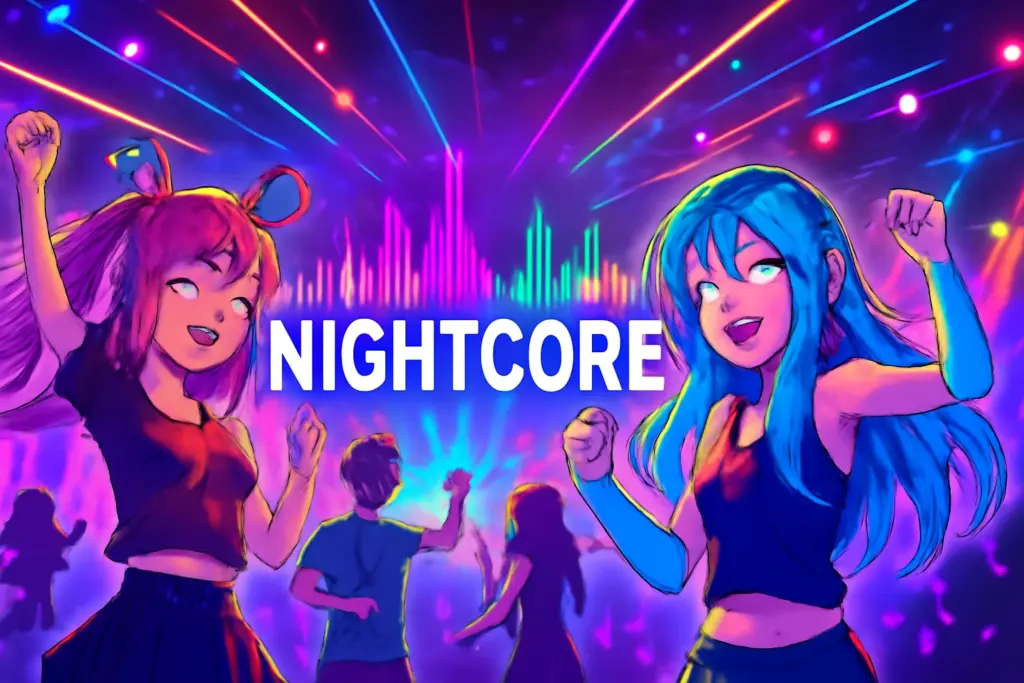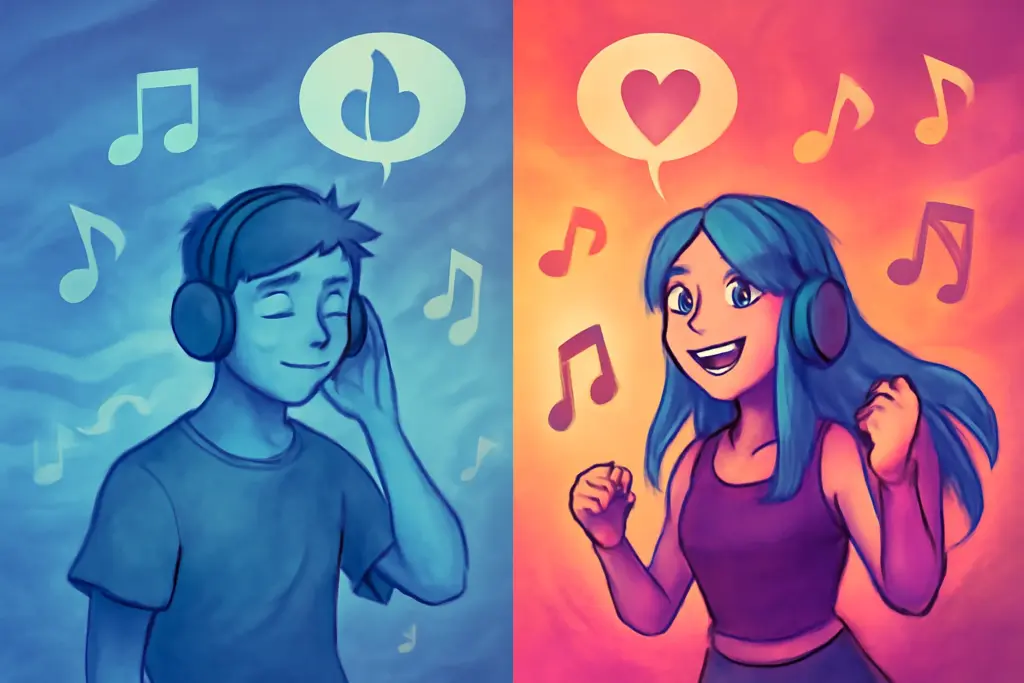If you’ve ever fallen into the depths of a YouTube music rabbit hole at 2 AM, chances are you’ve encountered both slowed + reverb edits and nightcore tracks. At first glance, they may seem like two sides of the same remix coin — one slows things down, the other speeds things up — but the feelings they evoke, the communities that surround them, and the reasons people love (or hate) them couldn’t be more different.
This post dives deep into both worlds, from their origins and aesthetics to the reasons they’re still thriving in the age of TikTok and Spotify playlists.
What Exactly Is Slowed and Reverb?
What Exactly Is Slowed and Reverb?
Think of it as music soaked in nostalgia.
Popularized in the mid-2010s, the slowed + reverb genre became synonymous with lo-fi aesthetics, VHS visual loops, and an overwhelming sense of longing. Initially inspired by DJ Screw’s chopped-and-screwed mixes from Houston in the 1990s, the modern slowed + reverb style often just involves slowing down the track and adding some echo or reverb — but the effect can be hauntingly beautiful.
A great example? A comment from a slowed + reverb video of “The Night We Met” by Lord Huron:
“This sounds like something you’d hear driving through your hometown after years of being away. Everything looks the same but feels different.”
It’s music for memory-making. Or memory-haunting.
What Is Nightcore?

Now imagine that same song — but it’s been speed-run through a cloud of glitter and energy drinks.
Nightcore started back in 2001 by two Norwegian teens, Thomas S. Nilsen and Steffen Ojala Søderholm. They took Eurodance tracks, sped them up by around 20–30%, and gave the genre its iconic high-pitched, hyperfast sound. Over time, the label “Nightcore” expanded beyond Eurodance and started to include anime visuals, vocaloid aesthetics, and eventually EDM, pop, and even rock edits.
Today, if you search for a Nightcore version of any song — from Billie Eilish to Metallica — you’ll probably find one.
Aesthetic Showdown: Neon Lights vs Fuzzy Memories
Let’s compare the aesthetics side by side.
| Feature | Slowed + Reverb | Nightcore |
|---|---|---|
| Tempo | Slowed down (typically 0.8x to 0.9x) | Sped up (1.2x to 1.4x) |
| Visual Style | Vaporwave, VHS filters, sunsets, slow zooms | Anime girls, digital art, high-saturation effects |
| Mood | Nostalgic, melancholic, introspective | Energetic, playful, upbeat |
| Platform Popularity | YouTube, TikTok, SoundCloud | YouTube, TikTok, Anime AMV culture |
| Popular Tags | #vaporwave, #sadvibes, #aesthetic | #animeedits, #nightcorelife, #speedcore |
Did You Know?
🎧 The most viewed slowed + reverb video on YouTube — a remix of “Play Date” by Melanie Martinez — has over 300 million views.
⚡ Nightcore was originally coined as a DJ name, not a genre.
Why Do People Prefer One Over the Other?

Here’s where things get deeply personal — and a little messy.
We found a Reddit thread on r/slowedandreverb discussing Nightcore, and the opinions were split:
“Nightcore just feels too synthetic to me. Slowed + reverb is something you feel in your chest.”
“Nightcore helps me focus. It’s like ADHD background music that keeps me moving.”
And that’s the crux of it. Nightcore fans often lean into it for energy and escapism — the sugar rush. Slowed + reverb fans lean into it for comfort and introspection — the late-night drive.
Use Cases: When Do People Listen to These?
This was fascinating to uncover. Based on Reddit comments, YouTube playlists, and Spotify user behavior:
| Situation | Slowed + Reverb | Nightcore |
|---|---|---|
| Late-night drive | ✅ | 🚫 |
| Workout/gym | 🚫 | ✅ |
| Breakup/melancholy | ✅ | 🚫 |
| Studying | Maybe | ✅ |
| Vibing alone with headphones | ✅ | ✅ |
| Anime edits or AMVs | 🚫 | ✅ |
Nightcore is more functional. Slowed and reverb is more emotional.
Cultural Influence and Evolution
Both genres have grown far beyond their original formats.
Slowed + reverb edits are now even officially released by artists (yes, Olivia Rodrigo, Doja Cat, and The Weeknd have approved slowed + reverb versions of their songs on Spotify). On the other hand, Nightcore has splintered into genres like Phonkcore, Speedcore, Hyperpop, and even Nightstep.
Did You Know?
💿 Spotify now has playlists entirely dedicated to official slowed + reverb versions.
📀 Some Nightcore creators produce tracks at 160–200 BPM, almost doubling the original tempo!
Criticism: Not Everyone Is a Fan
Despite their popularity, both styles have drawn criticism.
For slowed + reverb:
- “It’s lazy. Just dragging a pitch slider doesn’t make it art.”
For Nightcore:
- “Sounds like Alvin and the Chipmunks on crack.”
But here’s the thing — most people criticizing aren’t the intended audience. These genres thrive in niches. They’re not meant to appeal to mainstream ears. And maybe that’s why they feel so personal.
Which One is “Better”?
You might be expecting a winner. But this isn’t a battle of quality — it’s a matter of emotional alignment.
If you’re in a reflective mood, craving some lo-fi sadness with an aftertaste of high school memories? Slowed + reverb will wrap you like a blanket.
If you’re pumped, ready to vibe, or want your music to match your caffeine rush? Nightcore is calling your name.
Final Thoughts on Slowed and Reverb vs Nightcore
At the heart of both slowed + reverb and nightcore lies the same thing: transformation. These genres are ways for listeners (and creators) to take the songs they already love and reshape them into new emotional experiences.
In an age where everything is fast-paced and algorithm-driven, these remixes offer a strange sense of control — speed up the chaos, or slow it down. Feel more. Or feel less. It’s up to you.
Maybe that’s why we fall for them, again and again.
Whether you’re sinking into your headphones at 3 AM, watching the rain hit your window to a slowed Lana Del Rey edit, or headbanging to a sped-up Billie Eilish x Chainsmokers Nightcore AMV — remember this:
It’s not just about how a song sounds. It’s about how it makes you feel.
FAQs
Slowed and Reverb lowers the tempo and adds atmospheric reverb for a dreamy, mellow vibe, while Nightcore speeds up tracks to create an upbeat, energetic feel.
The slower pace elongates vocals and instrumentals, allowing listeners to absorb lyrics deeply, often triggering nostalgia or introspection.
Yes, but it’s more than that—it’s a subculture that originated from anime fan edits, giving songs a high-pitched, hyperpop energy.
No. They’re fan-driven remix aesthetics that live on platforms like YouTube, SoundCloud, and TikTok, rather than being recognized genres in the traditional music industry.
Both have strong followings, but Slowed and Reverb tends to dominate for moody edits, while Nightcore often accompanies anime-style content or energetic dance clips.
Yes. Creators frequently remix songs from all genres—pop, hip-hop, R&B, rock—though emotional or melodic tracks tend to work best for Slowed and Reverb.
While not started by one person, YouTube creator Jarys is often credited for popularizing the style in the early 2010s with “slowed + reverb” mixes.
It’s energetic, fun, and often nostalgic for fans of early 2000s internet and anime culture. Some say it helps with studying or workouts.
It exists in a legal gray area. Unless you have rights to remix the original song, technically it’s copyright infringement—though many platforms tolerate it under fair use or transformative content.
Slowed + Reverb is often preferred for calm focus or late-night sessions. Nightcore, being high-tempo, is better for tasks needing energy or alertness.
Want to explore more? Browse curated slowed + reverb playlists at ssslowedandreverb.com and dive into the feels.

Candy is the social media manager and resident content creator at SSSlowedAndReverb. A DJ herself, she brings her deep love for slowed and reverb music into every post, blending real-world experience with internet culture to create content that resonates with fans and creators alike.